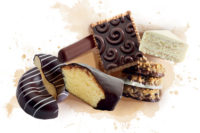
At first glance, one would think that the chocolate industry - faced with the possibility of even higher cocoa prices this year - is shifting toward cocoa butter replacements as a way to contain costs.
But as the chief executive officer of Aarhaus Karlshamn (AAK), one of the world’s leading suppliers of confectionery fats, points out in the company’s 2009 financial report, the global recession has dampened chocolate consumption by 5-10% in Europe and North America, with Easter European consumption declining by more than 10%.
And while a decline in chocolate consumption has tempered demand, “there is a general concern in the chocolate industry about the long-term supply of cocoa beans - and, therefore, also a concern about the supply of cocoa butter - because of problems in plantations, mainly in the Ivory Coast,” says Jerker Hartwall, AAK’s president and ceo.
Hence the idea that demand for cocoa butter alternatives would soar. But, as is typical with cocoa and chocolate production, it’s been more complicated than that. Yes, there’s growth in Cocoa Butter Equivalents (CBE) at AAK, although it doesn’t quite match the growth in 2008/2009, says Ed Wilson, v.p. – sales and marketing AAK USA.
“There was an increase in CBE usage in the EU [European Union] and South America … some in new customers, but others from slightly higher percentages in their current formulations,” he explains.
In the EU, where the standard of identity for chocolate allows up to 5% substitution of cocoa butter with cocoa butter alternatives, many companies have tweaked their formulations wherever possible to save costs, while ensuring functionality and flavor.
But, as Wilson points out, most companies in the EU don’t even max out at the 5% level with CBE’s. Rather, they average about 3.5%.
Moreover, in the United States, anything that’s labeled chocolate cannot have a CBE; the standard of identity is pretty clear - only cocoa liquor or mass and cocoa butter can be called chocolate.
Naturally, there are many manufacturers who use chocolate in conjunction with cocoa butter substitutes (see “Cocoa Butter Alternatives and Suppliers” for terms and suppliers), either using them as a filling or perhaps using a CBE to cap a chocolate bottom.
One emerging growth opportunity for cocoa butter substitutes - in addition to providing value confections dubbed chocolatey and/or chocolate-flavored - is in their use as an ingredient, be it cookies, nuts, pretzels, wafers and confectionery fillings.
As cocoa prices continue to remain volatile, confectioners as well as snack manufacturers can deliver true chocolate-like flavors in a less costly manner within a treat or food product.
Savvy consumers, while loyal to chocolate brands and flavor profiles, also are now, more than ever, willing to embrace value propositions, particularly those that combine flavor with convenience and health. Cocoa Butter Alternatives can certainly address those needs.
Cocoa Butter Substitutes
Cocoa Butter Substitutes (CBSs) typically are fractionated and partially hydrogenated lauric fat compounds - such as palm kernel and coconut oil - with steep melting profiles, resulting in a mouth feel and texture more similar to cocoa butter. Although they are not compatible with cocoa butter, they melt down and give flavor release equal to that of pure cocoa butter. Easy to handle because they crystallize rapidly in a stable form, CBSs have good gloss and good bloom stability. However, they can only tolerate only up to 5% of any other fat.
Cocoa Butter Replacers
Similar to CBSs, Cocoa Butter Replacers (CBRs) will not have any added cocoa butter. However, their tolerance to other fats is up to 20%. This allows the use of chocolate liquor, which contains more cocoa butter than cocoa powder does, as an ingredient. CBRs’ raw materials generally consist of non-lauric products such as soybean, cottonseed and palm oils.
Cocoa Butter Equivalents
Cocoa Butter Equivalents (CBEs) come closest to cocoa butter in its nutritional profile. They have similar handling properties common to cocoa butter and must be tempered. Typically a mixture of palm and shea oil, CBEs have a similar fatty acid profile to cocoa butter.
Global Suppliers
AAK USA
AAK USA, a division of AarhausKarlshamn (AAK), offers CBS products under its Cebes brand and CBE products under its Illexao range, which specializes in heat stability and bloom retardation. Other confectionery fats for use in chocolate are available under the Confao, EsSenced, Akopol, Chocofill and Barrier Fat brands. www.aak.com.
ADM Cocoa
In addition to offering compound coatings based on CBS and CBR fat systems, ADM Cocoa has the ability to make super compounds, in which “100% of the added cocoa butter [is] replaced with a CBE fat in order to behave and eat [the way] a chocolate coating would with cocoa butter,” says Adam Lechter, product services and development manager. www.admworld.com
Cargill
Under the Wilbur Chocolate brand, Cargill offers multiple products made with CBSs, including dark, white and milk chocolate-flavored coatings as well as a line of confectionery coatings made without hydrogenated fats. The company also offers its non-lauric Firstcoat line CBR under the Peter’s Chocolate brand, which is used as a bottom coat on confections. www.cargill.com
Fuji Oil Europe
Fuji Oil Europe, a division of the Fuji Oil Group, produces its CBSs from lauric vegetable fats. It also has non-hydrogenated lauric CBSs in its range. Fuji Oil non-lauric CBRs are available through its Melano range. Its range of CBEs and CBIs (Cocoa Butter Improvers) falls under its Palmy brand fats or on enzymatically interesterified fats. www.fujioilusa.com
Loders Croklaan
The Loders Croklaan coating fat product line includes coating fats based on palm kernel stearine, hydrogenated palm kernel oil, blends of palm oil and palm kernel oil as well as a full line of cocoa butter equivalents. www.croklaan.com



